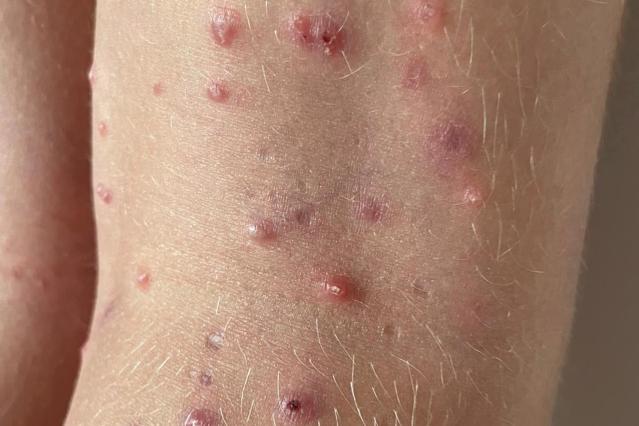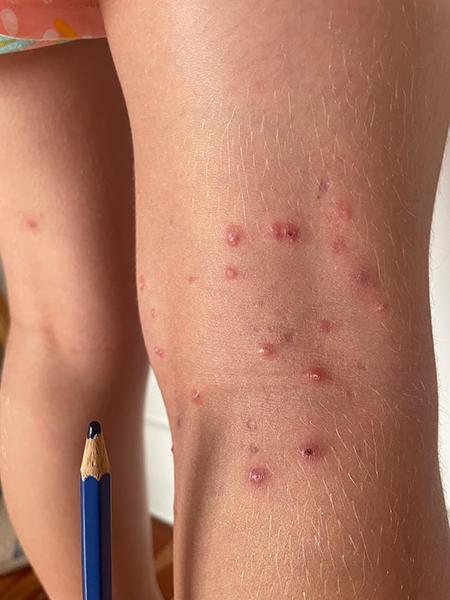Key points about molluscum contagiosum
- molluscum contagiosum is a common skin infection that is caused by a virus
- it causes small raised bumps on the skin
- the bumps are not sore but can be itchy
- molluscum spreads easily
- the bumps usually clear up on their own, but some tamariki may need treatment
What is molluscum contagiosum?
Molluscum contagiousum (molluscum for short) is a skin infection that is common in tamariki. It causes small raised bumps that can appear anywhere on the body. Molluscum spreads easily around the body and between people. It is caused by a virus.

Molluscum on the back of a child's legs.

A close up of molluscum on the back of a child's legs.
Who gets molluscum
Molluscum mainly affects young tamariki under the age of 10 years. Rangatahi (young people) can also get molluscum, but it is not as common.
Most adults have been exposed to molluscum when young. That means they're protected against it. Parents are unlikely to become infected after touching their child's molluscum.
Signs and symptoms of molluscum
- molluscum causes small raised bumps on the skin
- they tend to be skin coloured or slightly pink
- the bumps are about the size of half a pea or a little bigger
- the bumps are round and can have a dimple in the middle
- they can appear in clusters

A photo of the small raised bumps of molluscum - behind the knee. The pencil helps show the size of the bumps.
Source: KidsHealth
Molluscum can show up anywhere on the body. But the bumps often appear in warm, moist places such as:
- the armpit
- behind the knees
- the groin area
Molluscum doesn’t happen on the palms or soles. Molluscum is not painful but can be itchy.
How molluscum spreads
Molluscum can spread easily to other places on your child's body and to other people.
Molluscum can spread around the body when tamariki touch the infected area and then touch another part of their body.
Common ways it can spread to others include:
- direct skin-to-skin contact with someone who has molluscum
- from sharing things like towels
- through infected water, such as a bath
Preventing molluscum from spreading
Because molluscum spreads easily, good hygiene is important. This will help reduce the chance of it spreading between tamariki.
Try the following tips if your child has molluscum.
Care when touching your child’s skin
Wash and dry your hands well after touching your child’s skin with molluscum.
If your child has plasters covering the molluscum, throw them away carefully.
Towels and clothing
Don’t share towels or clothing.
Dry the skin with molluscum bumps last. The virus can spread when drying with a towel.
Bathing
It’s best for your child to have showers instead of baths if possible. The molluscum virus can spread in bathwater.
Make sure your child doesn’t share baths with other tamariki.
Don’t use bath toys. Or, if you do, make sure to clean and dry them after using them.
When to get medical help for molluscum
If you think your child may have molluscum, it’s a good idea to see your doctor. It may be helpful to take some photos of your child's skin with you when having a health check.
Managing molluscum
Most tamariki won't need treatment
Most tamariki won't need any treatment for molluscum. The bumps normally clear up on their own. Molluscum usually clears up 6 to 18 months after it appears.
When to consider treatment
Tamariki may need treatment if they have bumps on and around their face, especially if the bumps are worrying them.
Tamariki with low infection-fighting ability (low immunity) may need treatment. The virus can take longer to clear for them.
For tamariki with both eczema and molluscum, it's important to focus on good eczema management before looking at options to treat the molluscum.
Treatment for molluscum
There are several different treatments for molluscum, but none of the options are totally effective. If your child needs treatment, your child’s doctor will discuss the best option with you.
Creams and ointments
The doctor may recommend your child puts a cream, lotion or ointment on their bumps. There are several different options, and some can irritate the skin around the bumps. Your child's doctor will talk you through how to use these safely.
Liquid nitrogen
Some doctors may recommend freezing the bump with liquid nitrogen. This can be quite uncomfortable. Doctors don’t usually recommend this if your child has lots of molluscum all over their body. Liquid nitrogen may leave a white spot on the skin where the molluscum used to be.
Surgical and laser treatment
Other treatments include:
- scraping the bumps with a small surgical tool (curettage)
- laser treatment to the bumps
- removing the core of the bump with a needle
Some of these treatments can lead to scarring once the molluscum has gone.
Possible complications from molluscum
Infection
If molluscum bumps are scratched or bumped, they may become infected with a bacterial infection. If the skin around the molluscum becomes red and irritated, take your child to the doctor. They may need some antibiotics to treat the infection. Antibiotics will not get rid of the molluscum bumps but can help clear the infection around them.
Scarring
Some tamariki may be left with scarring after the molluscum clears up. This can happen with or without treatment, but some treatment options may make scarring more likely. Scratching or irritating the molluscum often may also lead to scarring.
Does my child need time off from kura or school?
Tamariki don’t need to take time off school or activities.
Molluscum can take months to years to clear up. Tamariki with molluscum are usually otherwise healthy.
Acknowledgements
Molluscum photos property of KidsHealth.
